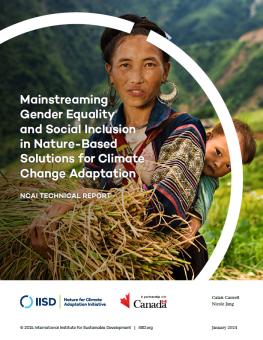
Mainstreaming Gender Equality and Social Inclusion in Nature-Based Solutions for Climate Change Adaptation
Discover tools, recommendations, and case studies on how to plan, design, and implement nature-based solutions for adaptation that advance gender equality and social inclusion while enhancing resilience, biodiversity, and ecosystem integrity.
-
Equity-deserving groups have unique and specialized knowledge concerning climate adaptation and biodiversity loss prevention that should be respected and leveraged in nature-based solutions initiatives through meaningful engagement processes.
-
Populations that face systemic marginalization and discrimination are often disproportionately affected by the impacts of the climate and biodiversity crises.
-
International actors and scientific bodies acknowledge the importance of incorporating gender equality and social inclusion measures within nature-based solutions programming to enhance climate adaptation.
This technical report offers contextual information, tools, and recommendations to help plan, design, and implement nature-based solutions (NbS) for adaptation that advance gender equality and social inclusion (GESI) while enhancing resilience, biodiversity, and ecosystem integrity.
It contributes to the nascent field of gender-responsive and inclusive NbS by providing practitioners working on NbS programming with guidance on how to consider gender and other intersecting identity factors that are grounded in a human rights-based approach at each stage of their NbS projects. Looking beyond NbS projects, applying a GESI lens should become “business as usual” within all facets of climate adaptation and resilience planning, processes, and practices.
This report was developed through a review of relevant literature, case studies, and discussions with experts. It is part of a compendium of resources developed by the International Institute for Sustainable Development (IISD) for the Nature for Climate Adaptation Initiative (NCAI), which is supported by Global Affairs Canada. The resources include an introductory guidance note that provides an overview of basic terminology and concepts behind NbS for adaptation and a report that provides guidance on enhancing biodiversity co-benefits from implementing NbS for adaptation (along with two case studies).
You might also be interested in
For Nature-Based Solutions to Be Effective, We Need to Work with Indigenous Peoples and Local Communities
Nature-based solutions have been praised as a promising approach to tackling the twin crises of climate change and biodiversity loss. But some Indigenous Peoples and local communities are questioning the legitimacy of the concept and what it symbolizes. It is time to listen to what they have to say.
How to Make Nature-Based Solutions for Adaptation Work for Everyone
Effective nature-based solutions (NbS) for adaptation start with integrated climate risk assessments. These take-aways will help practitioners plan for inclusive and sustainable NbS.
Inclusive Nature-Based Solutions for Climate Adaptation
Discover how climate change and biodiversity loss impact people differently and how inclusive nature-based solutions for adaptation can help.
Enhancing Biodiversity Co-Benefits From Nature-Based Solutions for Adaptation in Practice
By sharing promising practices and lessons learned, these case studies seek to inform and inspire adaptation practitioners and planners to help ensure that biodiversity co-benefits are captured throughout the lifetime of a project.
